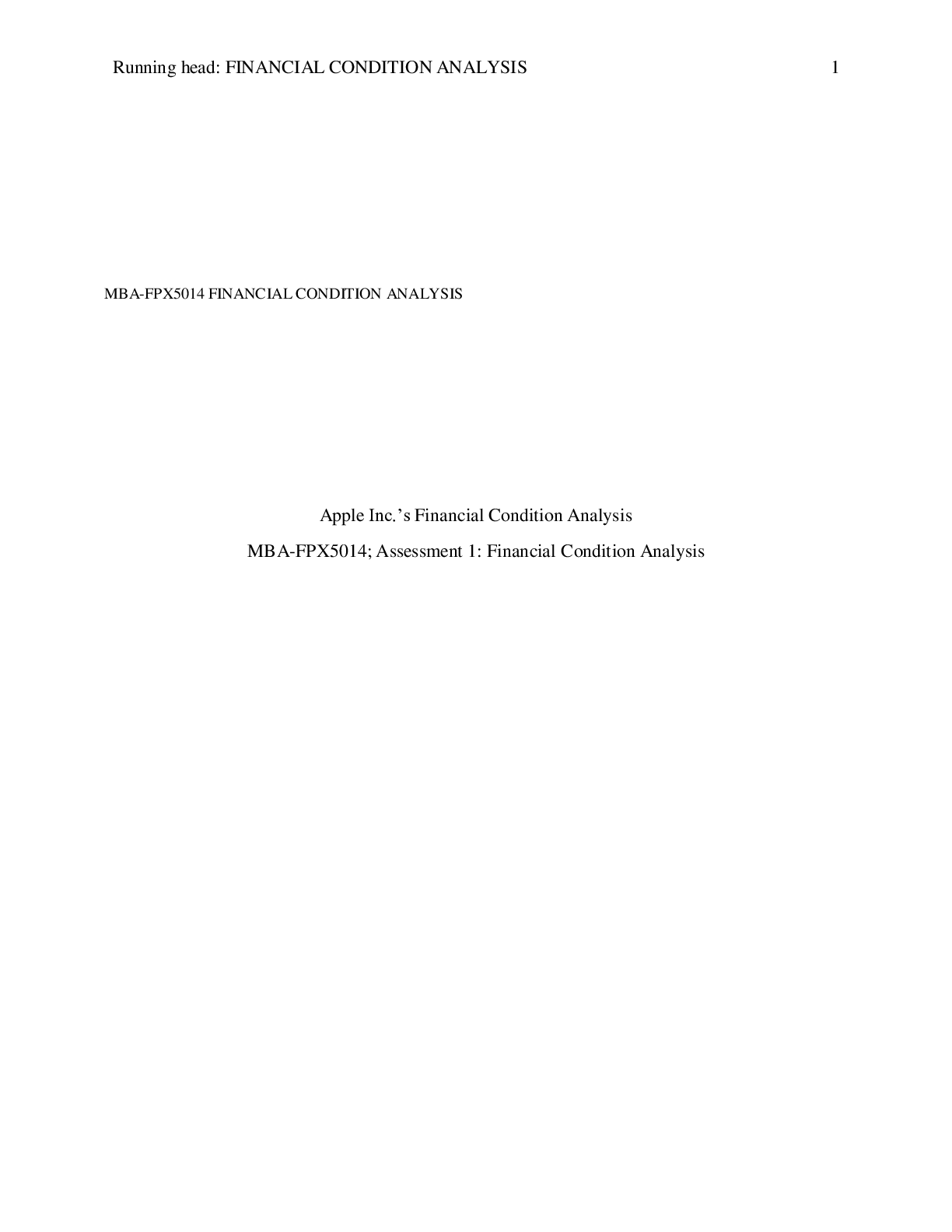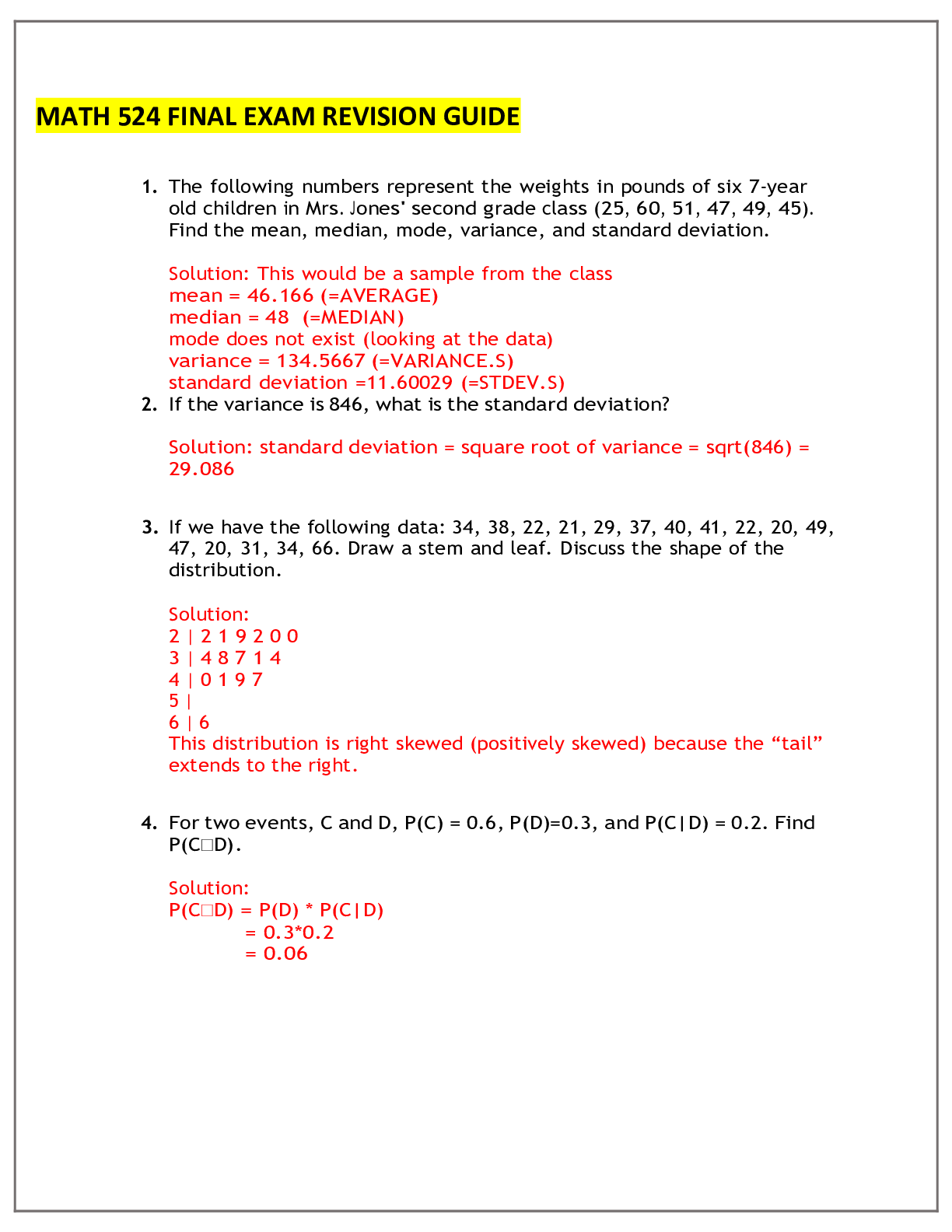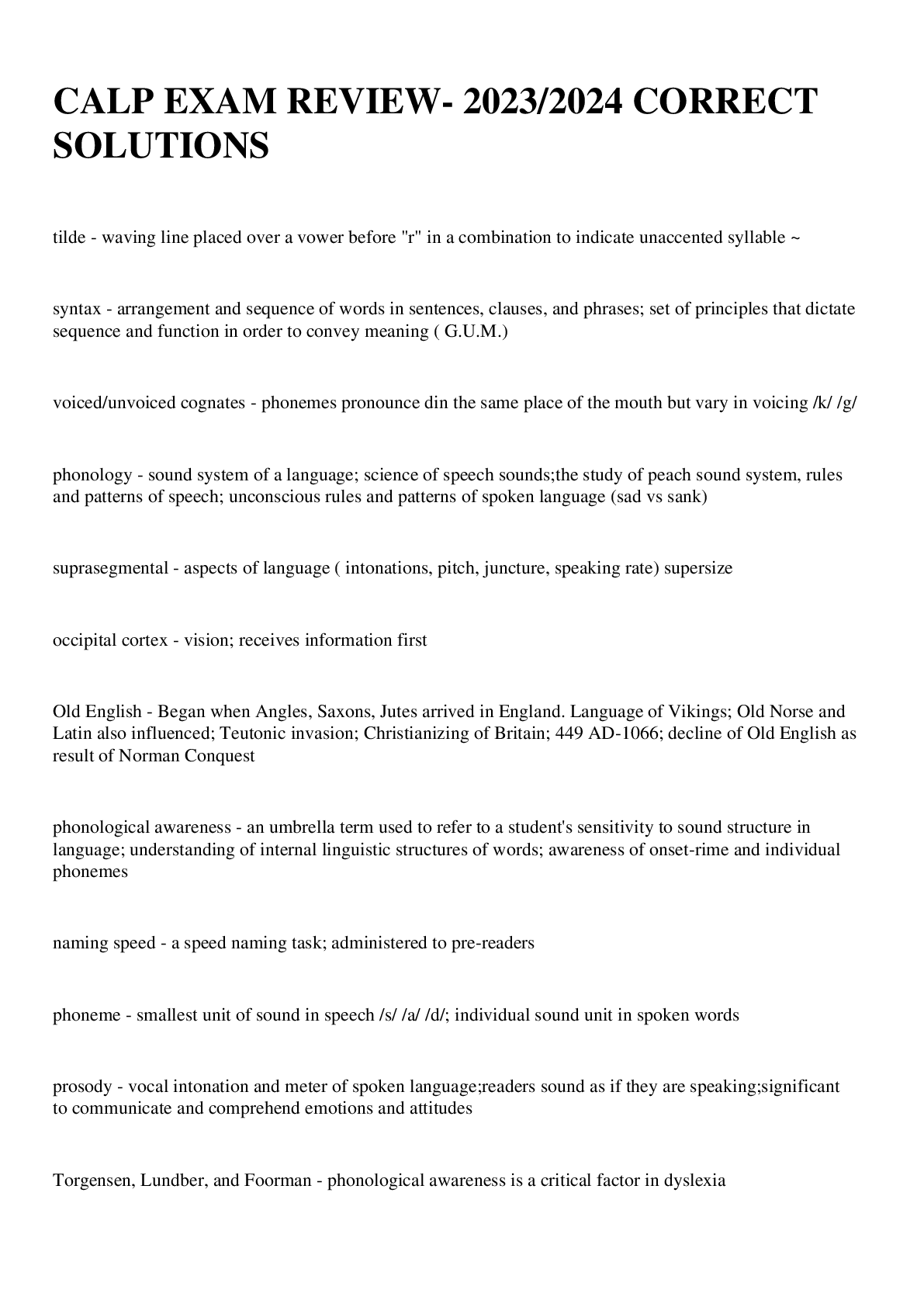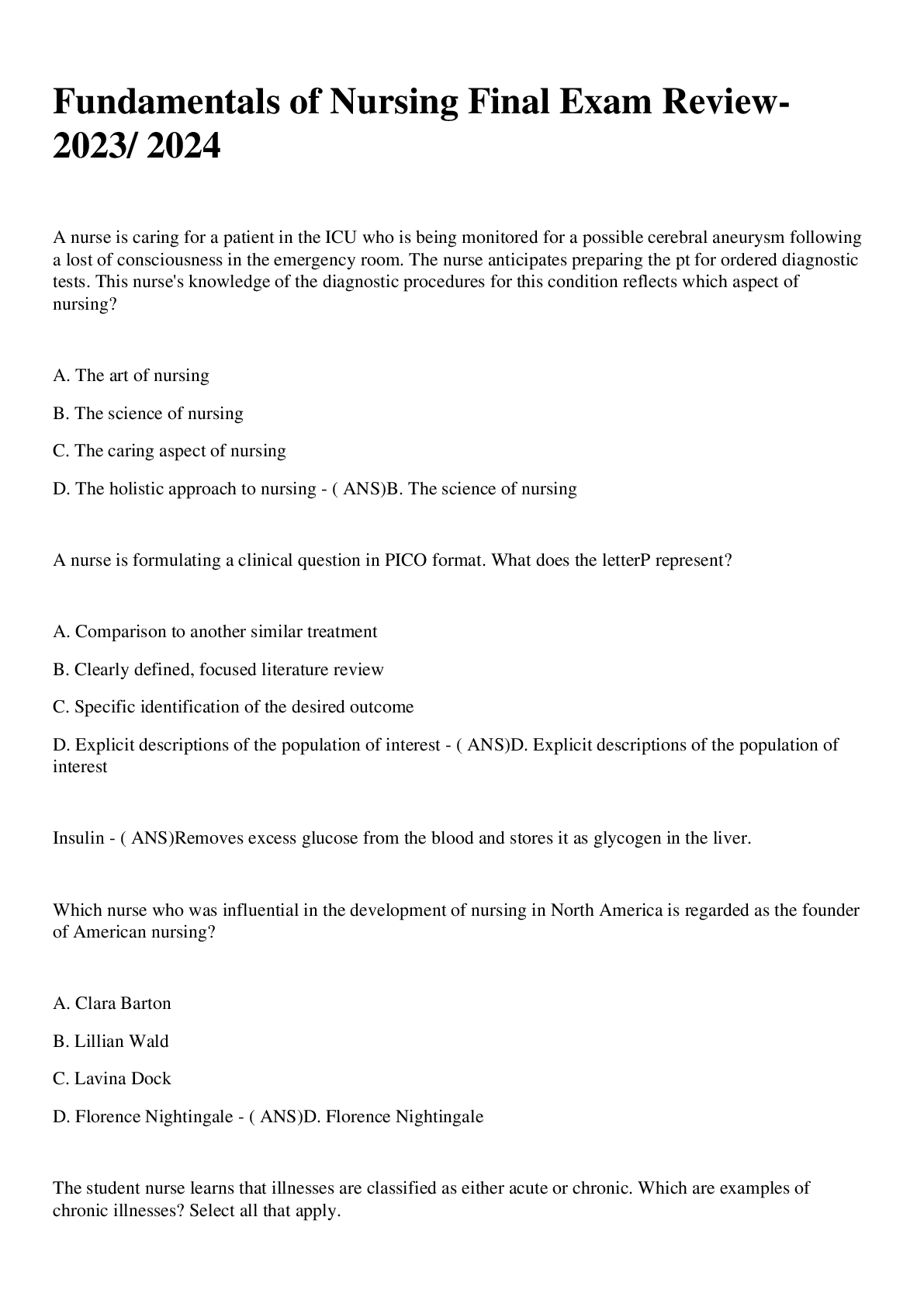Finance > Solutions Guide > MBA-FPX 5014 CONDITION ANALYSIS- FINANCIAL ASSESSMENT (All)
MBA-FPX 5014 CONDITION ANALYSIS- FINANCIAL ASSESSMENT
Document Content and Description Below
MBA-FPX5014 FINANCIAL CONDITION ANALYSIS Apple Inc.’s Financial Condition Analysis MBA-FPX5014; Assessment 1: Financial Condition Analysis Executive Summary It is essen... tial for financial advisors and upper management to know the financial condition of a company for a variety of reasons with a few being enforcing decisions to increase shareholder value and to distinguish the true value of the entity. PacificCoast Technology is seeking a high quality firm with solid financial health to purchase the business while allowing the current CEO, Maria Gomez to continue leading the business. She is considering being bought out by a larger publicity traded company so that she can be financially rewarded for all her innovative efforts. She is interested in finding a buyer that runs a high quality company with solid financial health and is able to take on PacificCoast Technology Company to its full potential, instituting growth. The financial advising team has evaluated and analyzed the financial health of Apple Inc. to acquire PacificCoast Technology. The following business report will analyze the financial health of Apple Inc., which is being evaluated to be considered as a possible merger for PacificCoast Technology. The past three years of financial statements; 2016 thru 2018 will be analyzed to determine the financial health of Apple Inc. and gain a better perception of the financial situation Apple Inc. is in that may enable them to merge with PacificCoast Technology. Apple Inc. is a well-known multinational technology company that has been around for many years achieving financial stability and trending reputation. Partnering with Apple Inc. would be the best choice as an appropriate partner for PacificCoast Technology because of their financial stability and outstanding reputation. By analyzing the financial ratio, leverage, operations, profitability and market values, the CEO will be able to make a decision on whether or not Apple Inc. would be a good fit for Pacific Coast Technology to partner with. Company Background Apple Inc. is a multinational technology company which designs, manufactures, and markets personal computers and related personal computing and mobile communication devices along with a variety of related software, services, peripherals, and networking solutions (Bloomberg, 2019). This company was established in 1976 by Steve Jobs and Steve Wozniak. Apple sells its products worldwide through its online stores, its retail stores, its direct sales force, third-party wholesalers, and resellers (Bloomberg, 2019). Apple is a well-known technological company which has held onto its ranks as the most valuable publicity traded company in the world (McClay, 2019). Apple continues to design new and unique mobile devices, tablets, smart TV’s, and computers world-wide. This is a plus for PacificCoast Technology because Apple Inc. sells its product nationally, exceeding geographical reach for many. Almost every year, Apple designs a new iPhone for its customers. This year, Apple had the pleasure of welcoming the new iPhone 11 and iPhone 11 Pro which is available in many colors. In 2018, Apple made history by becoming the world’s first $1 trillion company measured by market capitalization (Beattie, 2019). Apple is in fact valued by its customers because of the popular products that are created and the features of the products that come along with it. Apple’s biggest competitor is Samsung. Both performance and design are key drivers of the Apple products and its ongoing success (Beattie, 2019). In 2018, Apple’s market capitalization hit $974.42 billion and its stocks continue to rise! This is a huge hit and great opportunity for PacificCoast Technology because these numbers show that Apple Inc. is financially stable. Apple’s Financial Statements This section will examine the financial statements for Apple’s Inc. between 2016 and 2018. Ratio analysis is a quantitative method of gaining insight into a company’s liquidity, operational efficiency, and profitability by comparing information contained in its financial statements (Kenton, 2019). Ratio analysis involves evaluating the performance and financial health of a company by using data from the current and historical financial statements (Kenton, 2019). It is important for financial advisors and upper management to recognize the financial condition of a business for several reason which include improving the condition, make decision to increase shareholder value, and to know the true value of the entity. While a ratio analysis is used to compare line-item data from a company’s financial statement to reveal insights, it can also be used to look at trends over time for one company or to compare companies within an industry (Kenton, 2019). On the other hand, a financial statement analyzes the income statement, balance sheet and statement of cash flows for the company. The financial statement is intended to assist companies with making decisions and understand the overall health of an organization while evaluating its financial performance and business value (Kenton, 2019). Going back three years, we will review Apple’s financial statements between 2016 and 2018. The financial data which is seen below, will be examined for all three years. While looking at the net sales between those three years, it is obvious the net sales have increased, and are still continuing to increase as the years go by. Looking at the net income fiscal year ending September 24, 2016 in the balance sheet, Apple averaged $45.7 billion after cash generated from operating activities of $65.8 billion (Apple Inc., 2019). The increase in the net change in operating assets and liabilities was $484 million shown in the income statement (Apple Inc., 2019). Cash used in investing activities of $46.0 billion during 2016 consisted primarily of cash used for purchases of marketable securities, net of sales and maturities, $30.6 billion was used towards acquiring property which is found in the cash flow statement of the company. Cash used in financing activities of $20.5 billion during 2016 consisted primarily of cash used to repurchase common stock of $29.7 billion (Apple Inc., 2019). The total assets in 2016 totaled to $321,686, the total liabilities was $193,437 which has increased compared to the previous year. The financial ratio must be at least 2.1 which is calculated by dividing the net income by the average total assets. For instance, the financial ratio for 2016 would need to be calculated in order to determine if the company is in good ratio. Comparing this to the industry average ratios of 2.1, Apple exceeds because the average ratio overall, their stand point if well above 2.8 (Apple Inc., 2019). The financial ratios will be determined using the income statement, balance sheet and cash flow statement of the company’s 2016 statement. We calculate the liquidity ratio by dividing the total current assets by total current liability which totals to 1.35. While this still meets the capability of the company being able to afford paying their short-term obligations, the higher the ratio, the better. Apple’s total net income has greatly increased. The long-term ratio in 2016 is 2.8 with asset turnover of 61.62, net profitability averaging to 21.1868 and market value ratio of 4.44 (Macrotrends, 2019). The long-term ratio and asset turnover are in good standards as well as the market ratio. The industry average ratio for Apple in 2016 was 1.0. Compared to 2017 and 2018, 2016 is the same but has not decreased. However, looking at the following years, the average industry ratio increases (Macrotrends, 2019). It is not a tremendous change, but it is a slow but steady increase. Compared to the financial statements which were analyzed, the financial ratios are greater than that of the average industry ratio which is positive thing. Apple exceeds standards and based on the financial trend studied in the income and balance statement, Apple’s numbers continue to increase. Moving on to analyzing the income statement, balance sheet, and cash flow statement of Apple’s 2017 financial statements, we are able to identify that during 2017 (see below), the result of net income was $48.4 billion which has increased from the previous year (Apple Inc., 2019). The non-cash adjustments to net income of $20.8 billion and a decrease in the net change in operating assets and liabilities of $4.9 billion, which included a one-time payment of $1.9 billion related to a multi-year license agreement. About $46.4 billion was used cash that was used for organizational activities during 2017 which consisted primarily of cash used for purchases of marketable securities, net of sales and maturities, of $33.1 billion and cash used to acquire property, plant and equipment of $12.5 billion. Cash used in financing activities was $18.0 billion that was used to repurchase common stock of $32.9 billion (Apple Inc., 2019). While the expenses increased in 2017 than that of 2016, the net income also increased, gaining sales profit for the company. Based on the inventory cost and level, we are able to determine that the more inventory purchased, is depended on the high volume of purchases being made. Looking at the financial ratio for liquidity in 2017, the ratio is 1.27. Again, the ratio for determines that the company is capably of paying their short-term obligations. A ratio higher than one remains in good standard however, the higher the ratio better. The long term ratio for 2017 was 1.75 which has increased by 4% than the previous year. While the total assets were $375,319 billion in 2017, the assets had increased by 16.67% than 2016. The turnover ratio is 29.05 for 2017, which has also increased from the previous year. The annual gross profit was $88,186 billion which was a 4.66% increase from 2016 (Macrotrends, 2019). The ratio for profitability in 2017 was 2.5 and the market value ratio which is 6.02 (Macrotrends, 2019). Apple has and currently is still meeting the industry average ratio at a good standard point for each financial ratio analyzed. In 2017, Apple’s industry average ratio was 1.0 which is right at the target point. Comparing this to the industry average ratios of 2.1, Apple exceeds because the average ratio overall, their stand point if well above 2.5 (Apple Inc., 2019). Compared to the financial ratio of Apple that was examined, this ratio is less than the average financial ratio which were calculated. While 2017’s ratio may be lower than the industry ratio from the previous year, the business is still meeting ends goals. The financial ratio must be at least 2.1 which is calculated by dividing the net income by the average total assets. Apple reveals great numbers and currency as the stock price and gross margin increase annually. It does not seem that Apple has faced a bad year just yet, but the way the stocks and graphs are revealing statistics, it seems that customers are being faithful to the company which continues to progress. During 2018, the net income has increased compared to the previous year totaling to $59.5 billion (Apple Inc., 2019). The table below will examine the financial condition of Apple in 2018. There was also an increase in the net change in operating assets and liabilities of $34.7 billion, partially offset by non-cash adjustments to net income of $16.8 billion (Apple Inc., 2019). Cash used in financing activities of $87.9 billion during 2018 consisted primarily of cash used to repurchase common stock of $72.7 billion, cash used to pay dividends and dividend equivalents of $13.7 billion and cash used to repay term debt of $6.5 billion, partially offset by proceeds from the issuance of term debt, net of $7.0 billion (Apple Inc., 2019). In 2018, Apple’s gross margin increased by $13,653 and $36,361 billion in revenue in just one year! That is tremendous! This is able to prove to the CEO that Apple is continuously improving its revenue and net profit each year. Apple holds its value and reputation by also designing new products for its customers, annually. As different designs are being created, this brings in new customers, while maintaining loyalty of current customers in the company’s market. While it is common and usual for companies to be in debt, Apple does not carry much compared to other companies. Although Apple could have debt that needs to expensed, they are capable of doing so with that amount of sales revenue established at the end of each year. The financial ratios will be determined using the income statement, balance sheet and cash flow statement of the company’s 2018 statement. To calculate liquidity, the balance sheet is required to find the total current assets and totally current liabilities which we divide. The ratio for liquidity results to 1.13. This determines the company’s capability to pay for short term obligations and is in good standards because the ratio is greater than one. The long-term ratio in 2018 is 3.9 which is calculated by dividing the total number of long term debt by total assets in 2018 found in the balance sheet as well. We continue to calculate Apple’s financial ratio in 2018 by then calculating the turnover ratio which is 41.39, we divide the cost of goods sold (found in the income statement) by the average inventory which is found in the balance statement of Apple (Macrotrends, 2019). The profitability ratio in 2018 was calculated by dividing the gross margin by total revenue and resulted in a ratio of 2.6. This ratio is a 15.86% increase from the profitability ratio in 2017 (Macrotrends, 2019). It is important to keep track of the profitability ratio because it determines the gross revenue the company is performing annually and whether or not the company is progressing with its sales. In 2018, Apple’s shareholder equity was $107.147 billion which was a 20.07% decline from 2017 (Macrotrends, 2019). While this is a tremendous decline, it doesn’t much affect the net income Apple is holding because their net revenue and cash flow statement reveal increasing costs during the years being analyzed. The market value for Apple in 2018 is 6.3 which increased by some compared to 2017 (Macrotrends, 2019). Apple’s 2018 shares outstanding were $5 billion with a 4.79% decline from 2017 (Macrotrends, 2019). Compared to 2016 and 2017, 2018 seemed to have a greater decline however, their numbers are still rising in profitability (Macrotrends, 2019). The industry average ratio for 2018 was 1.2 but has since, increased to 1.5 (Macrotrends, 2019). Compared to the financial ratio’s that were analyzed, the average ratio tends to be slight less but still in good standards because the average is greater than 1.0. The industry average ratios of 2.1, Apple exceeds because the average ratio overall, their stand point if well above 3.0 (Apple Inc., 2019). Overall, the trend of Apple between 2016 and 2018 has been doing very well with progressing, as seen in the image below which compares the financial trend between 2016 and 2018. As we continue to discuss the trend over the period of three years, we will be able to recognize that the trend is growing at a fast pace. True Condition and Valuation of Apple CONTINUED......................DOWNLOAD FOR BEST REVISION GUIDE [Show More]
Last updated: 2 years ago
Preview 1 out of 16 pages

Buy this document to get the full access instantly
Instant Download Access after purchase
Buy NowInstant download
We Accept:

Reviews( 0 )
$10.00
Can't find what you want? Try our AI powered Search
Document information
Connected school, study & course
About the document
Uploaded On
Mar 08, 2022
Number of pages
16
Written in
Additional information
This document has been written for:
Uploaded
Mar 08, 2022
Downloads
0
Views
95








